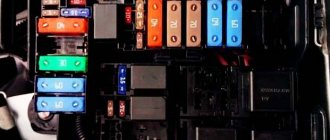The GLONASS system allows you to monitor vehicles in order to improve logistics processes, as well as reduce fuel costs. In addition, in the conditions of our country, such a device helps prevent fuel drainage, as well as stop “leftists”. Thus, many car enthusiasts are interested in how to deceive GLONASS or even disable it on a car . But it's not that simple.
In fact, there are two separate questions here: how to hide the movement of a vehicle, and also how to hide the fuel drain. In the first case, manipulations should be carried out with navigation equipment, in the second - with fuel meters. Now about this in more detail.
How does GLONASS work in a car?
Before you understand how to disable ERA-GLONASS on a Toyota car, you need to determine the operating principle of this system. In fact, its work is based on the interaction of satellites and ground-based devices.
Thanks to signal transmission, it becomes possible to track vehicles. The system works quite accurately, due to which the error anywhere in the world does not exceed several meters. With its help you can:
- monitor the vehicle’s route using GLONASS trackers;
- control fuel consumption;
- ensure driver safety (due to the presence of a panic button);
- get in touch with the driver, etc.
The system is quite young, so over time its functionality will expand even more.
Why is ERA GLONASS needed and how does it work?
ERA GLONASS is a system that is installed on a car and, in the event of an accident, allows you to send a signal to the dispatcher’s console, from where information about the accident goes directly to the rescue services:
- The system is activated either by a signal from sensors (they detect an impact/overturn of the car), or by pressing a button in the cabin.
- When triggered, the GLONASS module determines the coordinates of the vehicle via the satellite network, after which information about the coordinates and state of the vehicle is transmitted via the GSM network to the control center.
- The dispatcher attempts to contact the driver or passengers through the intercom. If the call has not been canceled, then an ambulance, traffic police, traffic police, the Ministry of Emergency Situations or other services are sent to the scene of the accident.
The system allows you to solve two problems: to minimize the time interval between the accident and the arrival of rescuers and to transmit to the rescue services complete and objective information about the scene of the accident and about the car itself. Some system models form a fairly extensive information package, which contains data up to the number of passengers at the time the “panic button” is activated (calculated by the number of activated seat belts).
Power off
Many people believe that there is no need to think about how to deceive GLONASS. After all, it’s enough just to turn off the system, then go about your business, and then turn on the device again. At the same time, such a solution has several disadvantages.
First of all, the dispatcher will receive a message that the device is disconnected from external power . In addition, the wire can only be pulled out by damaging the seal. Thus, everyone will know that GLONASS was disabled by the driver. As a result, the answer to the question: “What does turning off the power to the AutoGRAPH system lead to?” obvious: no use.
Why is disabling the Glonass era not recommended?
It is not worth turning off the satellite positioning system and communication with rescue services for several reasons. The most obvious is the impossibility of receiving help at the moment when it is needed, for example, in the event of an accident on a remote section of the highway.
The next reason concerns difficulties with paperwork. If during the next technical inspection a malfunction of the ERA GLONASS module is discovered, or its absence (if you remove it), then the diagnostic card required for issuing an MTPL policy will not be issued.
About Creta: The price of Hyundai Creta has risen for the second time in a month
Finally, more serious problems are possible. If a car gets into an accident, especially with human casualties, then turning off ERA GLONASS can be regarded as an aggravating circumstance. This is especially true for equipment involved in passenger transportation.
Antenna failure
Don't know how to break GLONASS? Everything is simple here: we take the antenna, and then simply break it off. Well, or you can bend/deform this element. After all, for the system to work properly, it needs a constant signal from at least 3 satellites.
You may also be interested in: How to remove the secret lock without a key if the key to the secret lock is lost
Thus, damage to the antenna will disable the device. You can also break the cable (for example, carefully break the cable with a needle, and then damage the wiring itself). But the shortcomings here are obvious - damage is easy to determine, so sanctions from management cannot be avoided. In addition, some devices can receive a signal even without an antenna, making the method completely useless.
How the system works
It is more difficult than determining the purpose of the system to understand how ERA-GLONASS works in a car. Its structure is similar to that of a smartphone, that is, it includes:
- navigation module;
- analogue SIM card;
- antenna;
- modem;
- microphone and speaker;
- control controller;
- a reserve source of energy maintenance in case of failure of the on-board network.
All these components are placed in the car so that the system is not damaged in the event of a collision. Only the button or key intended for the user remains visible. In more expensive cars it is hidden by a folding panel, but is still accessible.
About Creta: Creta Verano 3* (Greece/Crete district/Crete island/Malia). Hotel reviews. Rating of hotels in the world - TopHotels.
How to use ERA-GLONASS in a car depends on the operating principle:
- If it is manual, in a critical situation you should press the button for a couple of seconds or touch the window on the display. The system connects the user with the call center operator. Having received the signal, he must talk to the driver using the car's on-board system. The participant in the accident should explain the reason for the operation of the system, the need for assistance or its absence.
If he does not respond, the operator ensures that a group of doctors and rescuers is sent to the determined coordinates.
- In automatic mode, the system automatically activates after a collision. The collection of data about the accident, the vehicle involved, its speed at the time of the incident, the location of the event, the probable number of victims, and the severity of the damage begins immediately.
- The information package is sent to the call center via the Internet. This is possible even with a weak signal. And if there is no Internet at all, the information is sent as an SMS message. They go to the operator, who sends rescuers to help.
This is how the system should ideally work. It is clear that in order to function at the scene of an accident there must be a cellular connection (any operator). Its absence will make it impossible to use ERA-GLONASS. But even with a normal signal, as tests have shown, there are problems with quickly providing assistance to victims.
They are connected not so much with the smart system, but with the peculiarities of the work of call centers and emergency services. And also long distances, bad roads, and a reduced number of medical institutions.
Watch this video about how the ERA-GLONASS system works, its advantages and disadvantages:
Antenna shielding
Next on our list of how to disable GLONASS in a car is shielding the antenna. To do this, wrap it in a couple of layers of foil or other metal (the thicker the better).
Alternatively, you can use a magnet - at the same time, such a solution basically does not have any positive effect.
Damage to the terminal
As in the case of the antenna, such an action seems quite illogical. Yes, this will help get rid of surveillance for a while, but what will it do? Very soon the breakdown will be discovered, and the cost of repairs will be deducted from the salary. Perhaps they will even be fired - is a “leftist” really worth it?
So this option is not the best solution for how to disable GLONASS.
What car owners say
Reviews from owners of cars with the Era-GLONASS system will more clearly demonstrate the opinion of the people. Drivers write the following: “I am under constant surveillance for my money,” “No one is watching anyone, otherwise the price of a converted car would be significantly higher.”
It is important to remember that, if necessary, the device can independently turn off the engine, and not only notify emergency services about an accident. Perhaps not all drivers are ready for this, which is why the question of disabling ERA-GLONASS is relevant.
Use of special jammers
This option is the most practical. You just buy a special device that runs from the cigarette lighter. When you turn it on, the control room will receive a message that the satellite signal has been lost.
But if you use this method too often, they will soon realize that something is wrong with your vehicle. Finally, the method will not be relevant for dual-system GLONASS/GPS terminals. Here you need two different jammers.
↑ Guide to using the ERA-Glonass system
The system for calling emergency services in emergency situations, installed on the Lada Vesta, operates in two modes: automatic and manual.
Attention! Automatic configuration and data transmission in an emergency occurs when the ignition is on or the engine is running.
In the first seconds, the device carries out the following operations sequentially: conducts self-testing, picks up satellite signals, determines the real-time mode, and records the speed and direction. Based on the data received, it determines the coordinates of the vehicle's location.
The operator is provided with a minimum sufficient amount of information necessary to make a decision. He receives information: about the location of the car, the nature of its damage, possible injuries to road users, VIN, number, driving parameters before and after the collision. During the transmission of information to the contact center, the backlight of the emergency call button flashes.
When calling the operator:
- The sound of the radio is automatically reduced;
- the SOS key lights up intermittently red in standby mode;
- During a conversation, the light is constantly on.
The operation of the system can be determined by the interaction of the SOS button and the antenna pointer. When the ignition is turned on, the white backlight on the request button lights up and the indicator lights up intermittently red for 5 seconds. In the mode of waiting for a call from the dispatcher, SOS blinks red, the indicator is off. During a conversation with the operator, the SOS key lights up, the indicator does not turn on.
Cheating the fuel meter
In addition to the question of how to turn off GLONASS on a car, many are interested in a way to fool the fuel meter. It is worth noting that such devices are divided into:
- flow-through;
- submersible;
- ultrasonic.
You may also be interested in: Alloy wheels: advantages and disadvantages of wheel rims for a car
The first variety is suitable only for the warm period of the year, so it is practically not used in our time. We will talk about ways to bypass the last two devices below.
How to deceive GLONASS. Part one - spoiling trackers
Driver to director: “I know 15 ways to cheat the navigation.” Director to driver: “And I know 27 ways to reduce your salary.”
A lot of good and bad can be said about the widespread implementation of GLONASS. In general, the idea is excellent: the world has been using satellite technologies for logistics purposes and to reduce the fixed costs of maintaining transport for quite a long time. In Russia, everything is turned upside down: the connection of the vehicle fleet to GPS/GLONASS monitoring systems is initiated from above and is sometimes imposed in places where it cannot be of much use.
In cases where the implementation of GLONASS monitoring is absolutely justified, the process is slowed down by company employees - especially drivers. Everything is used: from open sabotage and vandalism to the law on privacy. On specialized forums (for example, here), operators and integrators of monitoring systems share with each other new ways to abuse innocent GLONASS terminals. I’ve been thinking and decided to combine everything I’ve read and heard in personal conversations into one article: it will be useful for pests to know what their tricks have long been known to employers, and employers, on the contrary, will find out what they will have to face.
The most common type of sabotage is manipulation of the antenna and body of the GLONASS tracker. Someone, without thinking twice, simply breaks off the antenna, someone carefully pierces it with a needle, someone wraps the entire unit or its individual parts in foil, someone - as in the picture below - places a hefty piece of iron or a magnet on the controller. The most hardworking and resourceful drivers make a special box from lead or other metal that completely covers the terminal. All these actions have a common goal - to make it impossible to receive signals from satellites.
And, of course, it would have been achieved if not for one “but”: equipment installers have long learned to protect devices from such tricks. Some operators of GLONASS monitoring systems initially recommend equipment with built-in antennas - i.e. those that require disassembling the terminal to damage. Well, then it’s a matter of technology: the devices are installed in places that are difficult for drivers to reach, the parts that need to be removed to access the antenna are sealed, and special stickers are attached to the unit itself. In addition, the satellite monitoring software is configured in such a way that when the controller diagnoses an antenna break or short circuit, it automatically sends a corresponding alarm message to the system. This, of course, will not protect you from vandalism, but it will warn you that the tracker “fell out of the zone” was not accidental. And he will delicately hint at the name of the guy who should be fined for the cost of the damaged iron.
For the same purpose - to cut off the GLONASS receiver from the navigation network - drivers try to damage the power system: they pull out fuses, cut wires, change the power polarity and even torment the unfortunate device with a stun gun. Let's start with the fact that almost all controller models are equipped with a backup power system: i.e. the terminal will work for some time after the sabotage. This time is quite enough for him to send an alarming message to the system that some bad person has played tricks and disabled the controller - and the recipients of the message will again know whose salary will be cut. Well, and, of course, if possible, the device is sealed on all sides so that there is no harm.
Example of damaged equipment: track charred due to impact on power circuit:
But everything I talked about above is about technically savvy drivers who are familiar with the operating mechanism of GLONASS equipment. There are also those who prefer not to delve into the subtleties - but simply disable the hated box that prevents them from driving official vehicles on unofficial business with impunity. These types break the entire terminal (to be sure), flood it with water, causing a short circuit - in general, they pervert as best they can. There is a control on them and its name is a vandal-proof case, a durable box that is not so easy to damage.
Protecting a specific device from a specific person is, in principle, a simple task. It’s worse when employees of different departments enter into an unspoken agreement with each other - and sabotage the work of a friendly company. For example, drivers may all complain about the malfunction of equipment and the inaccuracy of its readings, dispatchers may keep silent about “left” flights, and mechanics may delay and complicate the process of installing devices on vehicles. There is only one antidote here - a manager who cares about the results of the system. As practice shows, government organizations that do not have an owner and a flexible bonus system will not be helped by any paid or free satellite monitoring system - be it GLONASS or GPS.
Of course, this text hardly resembles a practical guide “How to deceive GLONASS and not lose your job”; it is difficult to combine all the achievements of creative drivers in one material. So if I forgot about something, write in the comments, I think it will be interesting and informative.
In the meantime, I’ll prepare the next episode - about how fuel sensors are deceived. The problem there is actually more difficult than with satellite terminals. But that's a completely different story.
Ultrasonic meters
These devices are mounted under the tank and use ultrasonic waves to evaluate the fuel level. It is quite easy to disable the device - a mild electric shock is enough. At the same time, the malfunction is very easy to detect.
A more intelligent method would be to install a magnet on the body. Thus, the meter begins to behave inaccurately, its readings are either overestimated or underestimated. As a result, this will undermine the car owner's trust in the meter, thus opening up several opportunities for fraud.
How to deceive dout?
Two types of sensors are used: ultrasonic and submersible. When a method is relevant for only one of them, this will be noted.
And again, the most trump and difficult options will be at the end:
- Bend the tank so that the sensor rests on the bottom or breaks completely. And again, physical force alone will not give anything: they will notice and force you to compensate for the damage;
- Bend the tube that is led into the tank using a metal hook. Submersible only! The result will be the same;
- Use electricity. Only ultrasonic meters! That is, shock the meter to disable it. But the reason for the breakdown will be obvious;
- Throw a metal object into the tank. There can be two goals here: either to reduce the volume of the tank, or to damage the sensor. And none will be achieved if a competent installer is found;
- Close the wires that transmit all the information from the sensor. But they will immediately find out about the deception as soon as the temporary problem is fixed;
- Pour boiling water over the sensor that is frozen due to the winter cold. Not suitable: the case either quickly gives off heat or conducts it poorly;
- Affect air drainage. The holes in it are responsible for ensuring that the sensor shows the true fill level of the tank. They need to be sealed, which is not so easy, because here you need to separate the FLS mount from the tank, and in many modern models it is sealed;
- Install a magnet on the case, due to which the readings will be inconsistent. Ultrasonic sensors only!
- Drain a little at a time while moving. Then the sensor will decide that the fuel was consumed for official purposes. You need to arm yourself with a tee with a tap and make sure that the inspector does not really bother himself with checks;
- Disconnect the car. This requires an experienced hand and a firm belief that the device does not have a built-in battery.
About Creta: Atlantica Caldera Creta Paradise 4* (Greece/Crete district/Crete island/Platanias). Hotel reviews. Rating of hotels in the world - TopHotels.
There are both effective ways and completely crazy ones. But any of them will become better if they join forces with the right people who can cover them and together resist the soulless technology. Again, you need charisma.
Submersible counters
Having figured out how to disable GLONASS in a car, many want to get rid of the fuel sensor. And if it is quite easy to deal with an ultrasonic counter, then in the case when a submersible model is installed on the machine, everything is somewhat more complicated.
Such designs are tubes located inside the fuel tank. The devices are very reliable and accurate, they resist water well and are not afraid of current. The only option to distort the readings of such a device is to bend it.
In this case, you need to act carefully. To do this, take a metal rod, then insert it into the neck and pry up the tube. You should not bend the tank from the outside - such actions are very noticeable, and there is a gap between the wall and the tube, so you cannot reach the meter itself.
Very bad options for hacking the system
Surprisingly, at first they tried to deceive the sensors or the GLONASS terminal in the car using very clumsy methods. Probably, some drivers and mechanics did not even try to understand the issue of how the entire system functions and what options are unacceptable.
Presumably, most of them were in the first wave of those fired for damaging property or stealing fuel. It is quite possible that some of them ended up in the dock.
- Fairly judging that there was electronics inside the terminal, they simply filled it with water or a more caustic liquid. Of course, it is possible to break the monitoring system in this way. But when contacting the tracker seller’s service center, the truth quickly emerged - after disassembling the case, the technicians saw characteristic oxidation on the microcircuits. It became clear that water had gotten inside. The driver had to explain how this was possible.
- Physical failure of the fuel level sensor . Why drivers compare the words “break” and “deceive” is not entirely clear, but it occurs quite often as an option. A simple option is to hit the head of the sensor with a hammer until it breaks. Only a fool doesn’t understand that he will then have to explain how this happened. More complicated options: use a crowbar to climb inside the tank lid and bend the measuring part; jump on the tank lid at the place where the FLS is attached, in the hope of bending the metal so much that the tube rests on the bottom and breaks. All cases are identified when contacting the company that installed the equipment - it is not easy to explain dents on the container, as well as a strangely bent tube.
- There is an absolutely fantastic way to deceive the FLS on the Internet. True, it is stated everywhere that this is working personal experience. The idea is that while the vehicle is moving, you need to fill the tank with 30 liters of fuel , and literally after about five minutes drain 20 liters. As noted above, this must be done on the go. It is argued that the sensor electronics will simply “go crazy” from sudden changes while driving. The non-standard method of deception does not stand up to criticism. Firstly, the sensor does not care under what circumstances the volume change occurred - it simply records the fact and transmits it to the terminal. Secondly, such tricks are very unsafe and you can get not to the manager on the carpet, but to the doctors for an unscheduled examination.
These are probably not all the amazing ways to deceive a car monitoring system, but the meaning is clear. In all such cases, management will quickly figure out who is the real culprit of problems with the equipment. You will have to pay for repairs. Most will likely be fired.
The surest way
If you want to damage GLONASS and drain fuel, then you need to act together with dispatchers and garage managers. Otherwise, any fraud will immediately appear. On the other hand, there are Iranian technologies that can replace real data from satellites. But they are not yet available to the general public, but are only the property of the military.
In general, these were all possible options that make it clear whether GLONASS can be deceived. It is worth noting that modern technologies are constantly evolving. They come up with new and new ways of protection. Perhaps the latest versions of devices are no longer affected by the tricks that were effective before. As a result, you should not tempt fate, because the game is often not worth the candle. If you have your own ways to deceive GLONASS, then write in the comments.
↑ ERA-Glonass diagnostic system and its malfunctions
The complex runs a self-testing procedure that determines its functionality. The operation of the microphone, speaker, indicator, and communication with the operator must be checked. Before starting diagnostics, you must turn off the engine. Then the ignition is turned on and remains in this position for at least 60 seconds. This is followed by a three-time switch back and forth from the “on” to “accessories” position with an interval of 5 seconds.
After 15 sec. The phrase will sound: “The testing system has been launched.” The indicator indicating the antenna lights up red. A few moments later, the phrase is heard from the speaker: “No errors detected. The microphone and speaker are being checked." You will then be prompted to “Say the passphrase.” The duration of the control message should not exceed 5 seconds. You will hear: “Playing passphrase.” The spoken phrase will be heard from the loudspeaker.
The end of testing is recorded after the words: “Enter the test result.” After which you will be prompted to re-switch the ignition switch “on” - “accessories” back and forth (interval no more than 3 seconds). If diagnosing the microphone and loudspeaker is successful, the phrase sounds: “No errors found. Test call in progress." The call is made, after which the driver is informed that the terminal testing was successful, the call and procedure are completed.
The indicator, which had been glowing red all this time, goes out. During diagnostics, the call key flashes red during a call, and is constantly lit during a call. The multimedia system is switched off when there is a voice message.
Important! Malfunctions are determined by the operation of the key and indicator lamps.
To determine the performance of ERA-Glonass, you must wait 60 seconds. after turning on the ignition.
If there is no connection with satellites, the backlight of the call button first lights up in white in standby mode, and during dialing and voice communication it lights up in red. The indicator does not respond when turned on.
When the battery is low and there is no ignition, the key lights up first white and then red. The indicator does not turn on.
If there is no connection with the operator, the key and indicator light red.
A malfunction of system components can be indicated by the red illumination of the SOS button and the blinking of the indicator in the red range.









